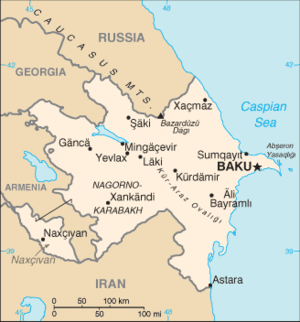Shafag-Asiman gas field
| Shafag-Asiman | |
|---|---|
| Country | Azerbaijan |
| Region | Caspian Basin |
| Location | 125km southeast of Baku |
| Block | Shafag-Asiman |
| Offshore/onshore | offshore |
| Operator | BP |
| Partners | BP (50%), SOCAR (50%) |
| Field history | |
| Discovery | 2009 |
| Start of development | 2023 |
| Production | |
| Estimated gas in place | 500×109 m3 (18×1012 cu ft) |
Shafag-Asiman (Azerbaijani: Şəfəq və Asiman) is a large complex of offshore geological structures in the Caspian Sea located 125 km (78 mi) southeast of Baku, Azerbaijan.[1] The Shafag and Asiman structures have been previously called D8 and D10, respectively.[2]
History
MOU for exploring the Shafag-Asiman structures was signed on July 13, 2009. According to the initial agreement, the offshore block will be jointly developed by BP and State Oil Company of Azerbaijan Republic (SOCAR). The MOU was signed by the President of SOCAR, Rovnag Abdullayev and Chief Executive of Exploration and Production of BP, Andy Inglis in the presence of President of Azerbaijan, Ilham Aliyev and former Prime Minister of the United Kingdom, Gordon Brown.[3] The MOU was followed by signing of Heads of Agreement on basic commercial principles on joint exploration and development of the fields by Rovnag Abdullayev and President of BP Azerbaijan, Rashid Javanshir on July 6, 2010, during the visit of President of BP, Tony Hayward to Azerbaijan.[1][4] The PSA for development and exploration of Shafag-Asiman block covers a period of 30 years with potential extension of up to 5 more years. First two exploration wells will be drilled within the next four years with possible extension of exploration works for 3 more years. All costs for exploration works will be covered by BP.[5] Development of Shafag-Asiman block is considered by some as extension of Azeri-Chirag-Guneshli (ACG) project, operated by BP.[6][7] Exploration works are expected to start in the second half of 2016 and continue through the second half of 2017.[8]
Reservoir
The offshore block covers an area of nearly 1,100 square kilometres (420 sq mi) which have never been explored before. The fields are located in a deepwater section of close to 650 to 800 metres (2,130 to 2,620 ft) with a reservoir depth of about 7,000 metres (23,000 ft).[3][9] The initial reserves are estimated to be about 500 billion cubic meters of gas and 65 million tons of condensate.[10] The 2D geophysical surveys previously conducted at block indicate that these deeply laying structures may contain big amounts of gas.[2] The 3D-seismic study in three stages is being carried out by Caspian Geophysical under BP contract. The first phase will be completed in 2011; the second data processing phase in 2012 and the third data interpretation phase in the first half of 2014.[8]
See also
References
- 1 2 "SOCAR and BP sign agreement on development project of oil and gas structures in Azerbaijan". Today.az. 2010-07-06. Retrieved 2010-07-06.
- 1 2 "SOCAR starts making technical concept of new refinery for Turkey's holding Petkim". Caspian Business News. 2010-07-06. Retrieved 2010-07-07.
- 1 2 "BP and SOCAR Sign MOU To Explore New Caspian Acreage" (Press release). BP. 2009-07-13. Retrieved 2010-05-21.
- ↑ "Tony Hayward's Visit to Azerbaijan". Financial. 2010-07-07. Retrieved 2010-07-07.
- ↑ "BP committed to Azeri energy projects despite sell-out speculation". Azernews. 2010-07-07. Retrieved 2010-07-07.
- ↑ Jeremy Beckman (2010-05-01). "Operators chasing further reserves in established/emerging offshore Middle East plays". Offshore Magazine. Retrieved 2010-07-07.
- ↑ "Azerbaijan's SOCAR and BP sign new agreement". News.az. 2010-07-06. Retrieved 2010-07-07.
- 1 2 E.Ismayilov (2011-08-08). "BP-Azerbaijan to launch drilling on Shafag-Asiman in 2016 (UPDATE)". Trend News Agency. Retrieved 2011-09-08.
- ↑ "BP ilə ARDNŞ arasında "Şəfəq" və "Asiman" perspektiv strukturlarının birgə geoloji-kəşfiyyatı və işlənməsinə dair anlaşma memorandumu imzalanıb" [BP and SOCAR signed an MOU for joint development and exploration of Shafag and Asiman prospect structures]. Azeri Press Agency. 2010-06-13. Retrieved 2010-07-07.
- ↑ E.Ismayilov (2010-06-04). "AFR Reserves of several perspective fields in Azerbaijan exceed 2.5tln cu.m gas". All Business. Retrieved 2010-07-07.
